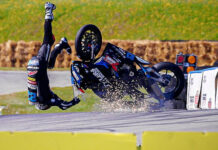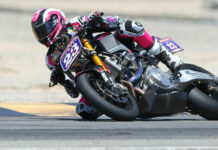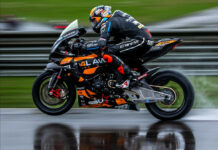Yamaha just released this story on European testing of the Yamaha YZR-M1 four-stroke GP bike. Yamaha hired freelance journalist Mat Oxley to write the story, then released it worldwide. The complete text follows:
By Mat Oxley
Yamaha’s YZR-M1 broke cover in Europe last week – the first of the new generation four-stroke GP bikes to run on the Continent.

Yamaha engineers and riders Max Biaggi, John Kocinski, Norihiko Fujiwara and Kyoji Namba spent three days at the Italian circuit of Mugello, running side-by-side tests with the factory’s current Marlboro Yamaha Team YZR500 GP bikes. The outing followed previous sessions at the Yamaha test track Fukuroi, Sepang and Phillip Island, and was the first stage of a European tour for the bike that will race in anger for the first time when it competes for the 2002 MotoGP World Championship.
The YZR-M1 opens an exciting new chapter in Yamaha’s Grand Prix heritage, following almost four decades of World Championship competition during which time the factory has conquered all three classes, most recently with victory in last year’s 250 and 500 manufacturers’ championships.
The shift to four-stroke power for GP racing’s premier class brings the sport more in line with the four-stroke dominated streetbike market, encouraging a greater degree of technological feedback from the track to the street.

Yamaha currently enjoys massive success in the streetbike sector with its epoch-making range of ‘no-compromise’ sportsbikes – the R1, R6 and R7. But the YZR-M1 – the M1 code following Yamaha’s traditional YZR race prototype prefix stands for Mission One – has no direct relationship to these machines. It is the embodiment of a free-thinking policy at Yamaha, a thought process aimed at producing a totally balanced race bike – a motorcycle designed around the rider that acknowledges user-friendliness as the surest way to race-winning performance.
For many years the YZR500 has been respected as the best-handling 500, so it has been Yamaha’s desire to instil the YZR-M1 with similar characteristics. To that end the YZR-M1 utilises a chassis closely related to the YZR500. And the choice of an in-line four-cylinder engine was made specifically to complement the chassis.
“We considered other types of four-cylinder engine, like a V4, but the in-line four suits our chassis best,” says Masakazu Shiohara, designer of the YZR-M1 engine. “It is all new, however, with no relation to the R1 streetbike motor. We also considered more cylinders but this means a heavier engine, which can compromise chassis design.”
Shiohara is the creative genius behind many of Yamaha’s Grand Prix successes. His first high-profile design was the OW20 in-line four 500 engine with which Jarno Saarinen led the 1973 500 World Championship. In 1982 he created the OW61 motor, Yamaha’s original V4 500, and soon after the first-generation YZR500. Shiohara was also responsible for the YZR250 powerplant and in 1997 the YZM400F motocrosser, his first four-stroke and the engine that revolutionised motocross. It is quite a CV.

Now Shiohara is repeating that journey, taking Yamaha’s GP roadrace bikes from the two-stroke era into their four-stroke future. It is an entirely original challenge in an age when racing means much more than straightforward horsepower performance. The new four-stroke GP regulations permit a maximum capacity of 990cc, which allows engineers to produce excessive power outputs of well over 200 horsepower, more than can be effectively used on modern-day racetracks. The real challenge is to produce controllable performance, power that works with the rider and the tyres, and that fits the 22-litre fuel limit (changing to 24-litre for 2002 and 2003).
“These are our biggest priorities,” adds Shiohara, who has been working on prototype engines for the YZR-M1 since 1999. “It would be easy for us to make an engine with more than 220 horsepower, but neither the rider nor the tyres would be able to usefully handle that over full race distance. Fuel consumption is also very important – 22 litres is not so much, so the engine and fuel system must manage consumption very efficiently.”
The YZR-M1 engine’s capacity is well under the 990cc limit and yet power output already exceeds 200bhp at around 15,000rpm. Like the marque’s other factory bikes, the YZR-M1 uses all Yamaha’s essential racetrack kit – five-valve heads, cassette-type gearbox, dry clutch and engine management system. Exotic technology such as pneumatic valves was considered but rejected.
“Power output is very similar to our current 500 GP bike, with a little more at the very peak,” explains designer Masakazu Shiohara. “But there’s a much wider spread of power and torque output is high, with a very flat curve. At the moment the engine revs to 15,000rpm or so, but of course we can go higher if required.
“We know from 500 racing that increasing peak power is not the way to improve lap times. These bikes already have maybe more power than riders can really use, that’s why we have focused on producing manageable power. We certainly looked at pneumatic valves and so on but considered them unnecessary since we already have more than enough horsepower. This is not F1 cars – motorcycle racing is more about the riders winning races with controllable power rather than ultra-high power outputs.
“I think the four-stroke will be easier to ride than a 500 because the power delivery is so smooth and linear. Everyone who has so far ridden the bike agrees with this.”
Biaggi and Kocinski both enthuse about the YZR-M1’s performance. Kocinski, a 250 World Champion with Yamaha in 1990, a former 500 GP winner and World Superbike Champion in 1997, has the perfect blend of racetrack experience to develop the YZR-M1.
“It’s a nice bike to ride, Yamaha has done a good job,” says the American. “They’ve got it to a high level very quickly. But racing is never ending – you’re always trying to make things better, so if you’re doing your job, you’re never satisfied. We are very close to 500 performance but right now we’ve got a little way to go. Five hundreds have been around for years and this bike has only been around for a few months. It’s not easy to beat a 500 – they’re very fast motorcycles, the fastest in the world. You can’t just come in and clobber them straight away but we’re getting there.
“They improve the bike every time I test, it’s a big challenge for all of us and I’m enjoying it. There’s a lot of potential there, it’s just a matter of squeezing it out. The power is definitely smooth but there’s one hell of a lot of it.”
Biaggi, currently contesting the 500 World Championship for the Marlboro Yamaha Team, has already ridden the bike on several occasions in between his GP commitments. The Italian has never raced a four-stroke and must accustom himself to the different characteristics, as well as the extra weight. Four-stroke regulations for a four-cylinder machine demand minimum weight of 145kg, 15kg more than current 500 requirements.
“The four-stroke seems to have similar power to the 500, but the character is different,” says the Italian. “The bike doesn’t feel so heavy, a little more than the 500, but not too much. The main thing I’ve been thinking about is the base chassis set-up. This is just a prototype machine so nothing is fixed – engine position, weight distribution and so on. As John says, it keeps getting better and it’ll be great when we can focus exclusively on the bike later in the year.”
Shiohara is working closely with Biaggi, team-mate Carlos Checa, Kocinski, Fujiwara and Namba as the days count down towards the YZR-M1’s race debut in 2002.
The man in charge of Yamaha’s current GP effort is Masahiko Nakajima. He was recently appointed GP500 project manager and last year oversaw the factory’s securing of the 500 Manufacturers’ title as Yamaha Grand Prix manager. His experience is a vital part of the YZR-M1 project, especially on the chassis side.
“We started from zero with this project, with one guiding principle – to produce a well-balanced motorcycle,” says Nakajima. “But if you consider that all the top 500s are similar in layout and dimensions, this suggests that this is an ideal configuration. That’s why we wanted to continue using our YZR-style chassis with the YZR-M1 – the engine was designed to fit within the package, not the other way around. Geometry and dimensions are very similar to the YZR500 and rider feedback suggests we have succeeded in reproducing that bike’s chassis character.
“With the new four-stroke Grand Prix machines, we believe that tyre life is the most crucial issue of all. We are working to produce an engine that looks after its tyres all the way to the finish of races and we are doing some good work with Michelin on tyre development. From a tyre point of view this new formula is a big challenge, because the extra speed, weight and torque of the four-stroke means a lot of extra work for the rubber.”
With around 200 horsepower on tap, wheelspin will obviously be a feature of four-stroke GP racing but Yamaha engineers do not believe that traction control systems will be a crucial feature of bikes like the YZR-M1. Rather their concern is perfectly linear power output to allow the rider to do exactly what he wants with the motorcycle.
“Again, this is not F1,” says Shiohara. “Bike racers need wheelspin, they use it to help steer out of turns, and in this situation, there’s no doubt that the rider is better than a computer. Of course, we will have some kind of traction control for especially slippery conditions, when it’s raining, for example.”
Michelin Grand Prix manager Jacques Morelli, who has attended several of Yamaha’s YZR-M1 tests, believes that the easy-wheelspinning character of four-stroke GP bikes will further increase the sport’s entertainment value. “It will make a great spectacle for the fans,” he says. “As tyre manufacturers, the increase in torque is the biggest factor for us, it creates a lot of extra stress on the tyres. But we have already started moving in that direction with our 16.5in rear slick. We have moved in that direction not only because it brings something to 500 racing but also because we were looking to four-strokes. The more power you have, the more rubber you need on the ground, and the 16.5 has a greater contact area than the 17in.”
There is no doubt that the new four-stroke regulations have added a further edge of excitement to the already buzzing MotoGP scene. As Yamaha develops its YZR-M1, rival factories are already developing their own machinery for the new series, including a V5, an inline three and a v-twin, with more on the way. For the next few seasons these machines will compete against the existing 500 two-strokes to create awesome sights and sounds at racetracks around the world.
Yamaha is in at the start of the four-stroke GP racing revolution and the factory aims to be ready to win when the battle for 2002 World Championship kicks off next spring.






